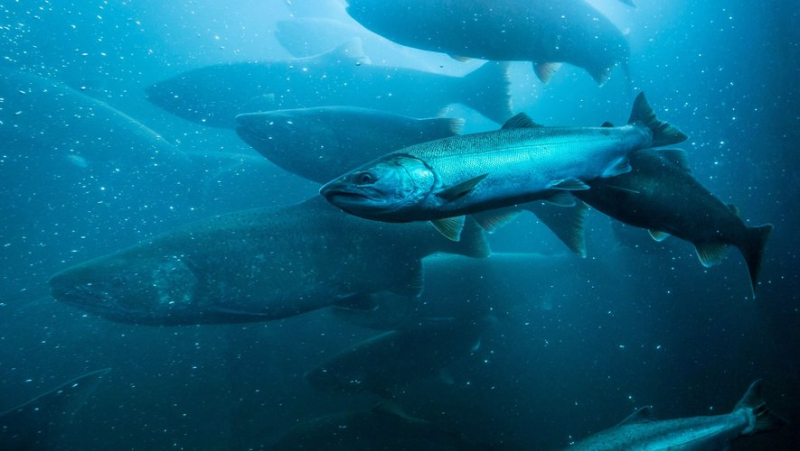Facing record mortality, are Norwegian salmon healthy ?

Près de 63 millions de saumons –un record– sont morts prématurément l'an dernier dans les grandes cages immergées dans les fjords du pays scandinave. DaveAlan/Getty Images
Vanté pour son Oméga 3 et ses vertus diététiques, le saumon norvégien n'affiche pas une grande forme dans les fermes piscicoles où il est élevé.
Nearly 63 million salmon – a record – died prematurely last year in large cages submerged in the fjords of the Scandinavian country, the world's largest producer of Atlantic salmon. That is an unprecedented mortality rate of 16.7%, which increases from year to year.
At issue: diseases (of the pancreas, gills, heart, etc.) but also injuries caused during operations aimed at ridding them of sea lice, parasites that feed on them of their host.
"The death of animals is a waste of lives and resources", notes Edgar Brun, head of the fish health and welfare division at the Norwegian Veterinary Institute. "We also have a moral, ethical responsibility to guarantee them the best possible conditions".
Not always pleasant
Salmon that die prematurely are usually processed into animal feed or biofuel. But, according to Norwegian media, it could be that fish that were sick at the time of slaughter, or even already dead, end up on the plates, sometimes under the label "superior& quot;.
"I see fish on sale that I myself would not eat", testified l' former quality manager in a slaughterhouse, Laila Sele Navikauskas, in November on the NRK channel. According to experts, its consumption does not pose a risk to human health. "Common pathogens that cause illness in salmon are not transmissible to humans" ;, assures Edgar Brun.
But these revelations harm the qualitative image that the sector is trying to establish. "If you buy meat in a store, it seems obvious to you that it comes from an animal that was slaughtered properly and not one that was lying dead outside the' #39;stable", argues Trygve Poppe, fish health specialist.
The Norwegian Food Safety Authority found irregularities in farms during every second inspection last year: injured or malformed fish were found been illegally exported in particular.
For reasons of reputation, only the export of superior or ordinary quality salmon is authorized. Lower quality fish, which constitutes a growing share of the stock, can only be sold abroad after processing, cut into fillets for example.
The stakes are high. Salmon exports earned Norway some €10 billion last year, with the 1.2 million tonnes sold representing the equivalent of 16 million daily meals.
Question of trust
For Robert Eriksson, head of the Sjømatbedriftene organization which represents small producers – generally considered more virtuous -, the discrepancies reported among certain breeders are "totally unacceptable". "We live on trust", he said.
Taking shortcuts, "it's like pissing in your pants: it only warms you for a moment"< /em>, he adds. "Then, we are punished by the market and the economic impact is much greater than the few extra kilos we will have sold".
Sjømat Norge, the association representing the large aquaculture groups – the most often singled out – says it is mobilizing but requires time.
"On average, it takes three years to raise a salmon", underlines its director, Geir Ove Ystmark. "It is therefore difficult to see immediate results today even though we have launched a whole series of initiatives and measures".< /em>
It's precisely the speed at which the fish are raised that poses a problem, according to Trygve Poppe, critic of "animal conditions terribly bad".
"Salmon are subject to stress throughout their lives, from hatching in fresh water until they are slaughtered", argues this former veterinary school professor, who says he stopped buying farmed salmon. "By For example, during the first phase in fresh water, we manipulate the light and temperature so that it grows as quickly as possible: in the wild, this phase takes two to six years. In breeding, it's between six months and a year".
Beyond ethical considerations, strengthening animal welfare responds to economic logic: 63 million salmon dying before their time is nearly 2 billion ;#39;euros of shortfall.
According to Truls Gulowsen, leader of Naturvernforbundet, the Norwegian branch of the Friends of the Earth movement, the increase in mortality is the result of "industrialization& quot; too pushed."We have genetically created a farmed fish that has poor survival skills and dies from a combination of stress and bad genes because it was bred for grow as quickly as possible and underwent a sudden change in his diet", he said.
Areas for improvement
Sjømatbedriftene aims to reduce mortality by half by 2030, and the giant Salmar has invested more than 40 million euros to work on the issue.
Among the avenues mentioned, increased spacing of aquaculture farms and new technologies, in particular so-called closed installations where the water is filtered. This technology would help protect against sea lice, but it is more expensive.
The government emphasizes the responsibility of breeders to respect regulations.
"Not all producers have the same mortality rate, it is possible to lower it", notes the Secretary of State at the Ministry of Fisheries, Even Tronstad Sagebakken.
Two texts in preparation, one on animal welfare and the other on the exploitation of the seas, should, according to him, contribute to this. In the meantime, the Food Safety Authority says it is still receiving reports that non-regulated salmon continues to leave the country.




